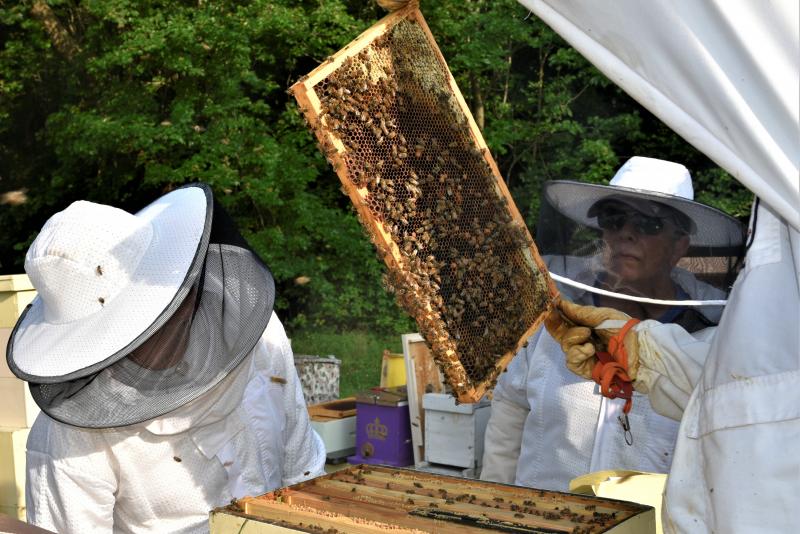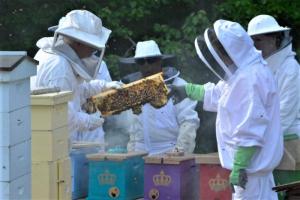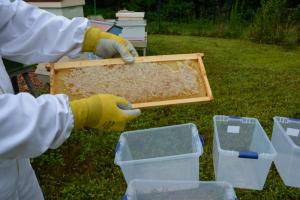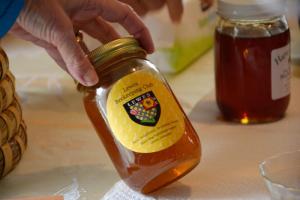With spring right around the corner, several Cape Region residents are buzzing with anticipation for warmer weather and the emergence of their black-and-yellow friends.
Founded in 2016, the Lewes Beekeeping Club has brought together a diverse group of nearly 50 members who care for more than a half-dozen hives at four locations in Lewes and Milton.
Denise Bridgens formed the group after completing a class at Osher Lifelong Learning Institute.
“It really helped us understand how critical bees are to our current lifestyle and the future,” Bridgens said of the class.
Several of her classmates joined the club that first year, and it’s continued to grow each year. They had initially searched for a local beekeeper to help, but when that didn’t pan out, they collectively funded an effort to purchase the necessary equipment and supplies to start their own hives.
Membership was primarily women over 60 years old through the first few years, but more men have joined recently, Bridgens said. The club still attracts mostly retired folks. Bridgens said its demographic breakdown is pretty unique, as most beekeepers across the nation are much younger.
The mission of the club is to teach the art and science of beekeeping to members, but also teach the community at large about the importance of honey bees and other pollinators to the health of the planet.
Pam Meador, an original member, said the club has brought together an interesting collection of people.
“Everybody that’s a part of this club is different,” she said. “We have retired engineers, a retired veterinarian, a former this and a former that. It’s an interesting conglomerate of people, but it really makes this club work. They all bring something different.”
Meador said joining the club is a good first step to being a part of the community, especially for someone who feels their voice isn’t being heard on the state or national level.
“It a way to have an impact in your own community and feel like you’re doing something,” she said.
Meador doesn’t visit the hives too often. She instead works hard to promote the club in the community. One of her favorite events each year is a presentation to children at the Lewes in Bloom Children’s Learning Garden in Stango Park. She dresses up like a bee and offers easy-to-understand facts to young learners.
“I’m like a queen for a day,” she said.
Club President Linda Rancourt joined in 2017 after moving to Lewes permanently.
“I didn’t have any beekeeping experience,” she said. “I was always interested in nature and bird watching, but this was the first time I considered that beekeeping might be a fun thing to do in retirement.”
The club’s busiest time of year is typically spring and summer. Bees will not come out of the hive until the weather is about 55 degrees. They may poke their heads out during warmer winter days, but they won’t find much food. Among the first pollen-producing plants to bloom in spring are red maples and dandelions, Rancourt said.
Once bees are able to bring pollen back to the hive, the queen will start laying eggs; she can typically lay 1,000 to 1,500 eggs in a day.
Rancourt said some hives are at risk of overcrowding, which is one of the things members look for when visiting hives.
“We have to watch for swarming in April/May,” she said. “They will swarm if they don’t have room to grow.”
While there are measures to mitigate swarming, it’s also an opportunity to start a new hive if the club is prepared.
Bridgens said they also need to watch for pests and predators that can feast on a hive. Small hive beetles and varroa mites are common pests, she said, but carnivorous bald-faced hornets can be very problematic.
Tim Campbell, who joined the second year, said the club taps into the expertise of university professors when confronted with a new problem.
“There’s a saying, if you ask 10 beekeepers about a novel problem, expect to get 12 answers,” he said.
While access to experts is nice, he said, sometimes the best answer comes from a local beekeeper. Outside the Lewes Beekeeping Club, there are also other clubs in Sussex and Kent counties that serve as great resources.
Like many other members, Campbell had no experience with bees prior to joining the club. But the learning experience has been addicting, he said.
“What makes beekeeping interesting is finding unexpected things and trying to figure out if it’s a problem we’ve dealt with before or something new,” he said. “We’ve been at it long enough that we’ve seen a lot of things for the first time.”
All in all, Bridgens said the club has been a success, providing educational and positive experiences for dozens of people in the community. Personally, she said, it’s very rewarding.
“There’s nothing like picking up a frame and seeing all these baby bees poking their heads out. It’s like a chick being born,” she said. “It’s the most adorable thing. It warms your heart.”
She said there’s something special about watching the entire life cycle of a bee, which is about six weeks. Beekeepers also learn a lot about the personality of each hive, she said.
“Some queens are docile; some are aggressive,” she said. “Hives take on her persona.”
COVID has provided a unique challenge. Although beekeepers wear protective suits, members were still required to mask up and social distance, when possible.
After canceling in-person meetings early in the pandemic, the club jumped on the Zoom train for monthly virtual meetings. As far as tending to the hives, Rancourt said the club chose a small group, primarily four people, to check on the hives throughout the summer.
“We really do our best to make the bee yard visits as safe as possible,” Campbell said. “You really can’t maintain strict social distancing, but everybody is masked. It puts more of a work burden on the fewer number of people involved.”
The club’s usual outreach events such as Coast Day were canceled in 2020, so they’ve tried to beef up virtual meetings with guest speakers to keep people engaged and informed.
One of the fruits of the club’s labors is honey. They typically extract 100 to 140 pounds of honey each year. It’s then sold to members and others outside the club. The revenue is used to sustain the club’s costs for insurance, website and other annual expenses.
While honey is a nice benefit, Campbell said, maximizing honey production is not a focus.
“It’s really about helping members understand more about honey bees and their place in the environment,” he said. “We want members to understand what goes on in the hive and to put their hands in the hive. That actually causes the hive to produce less honey, because we’re interrupting the bees from their work. Producing honey is not as important as opening up the hives for the members.”
To learn more about the Lewes Beekeeping Club, go to lewesbees.org. The club also has some interesting videos on YouTube. They can be found by searching for Lewes Bees.
By the numbers
- $18 billion - Value of added revenue to U.S. crop production from pollinators
- $700 million - Total annual value of U.S. honey bee products and services sold
- 2.8 million - Number of honey bee hives in the U.S.
- 7,200 - Number of bee colonies in Delaware
- $2.5 million - Value of honey bee industry in Delaware
- $30 million - Annual contribution bees make to successful production of fruits and vegetables.
Source: U.S. Department of Agriculture and Delaware Department of Agriculture





















































